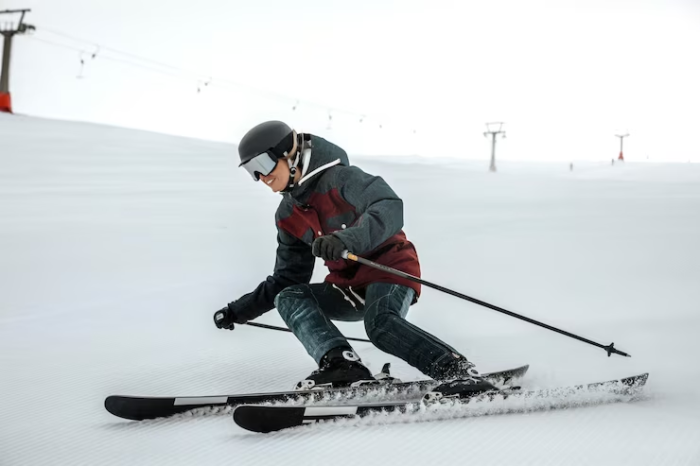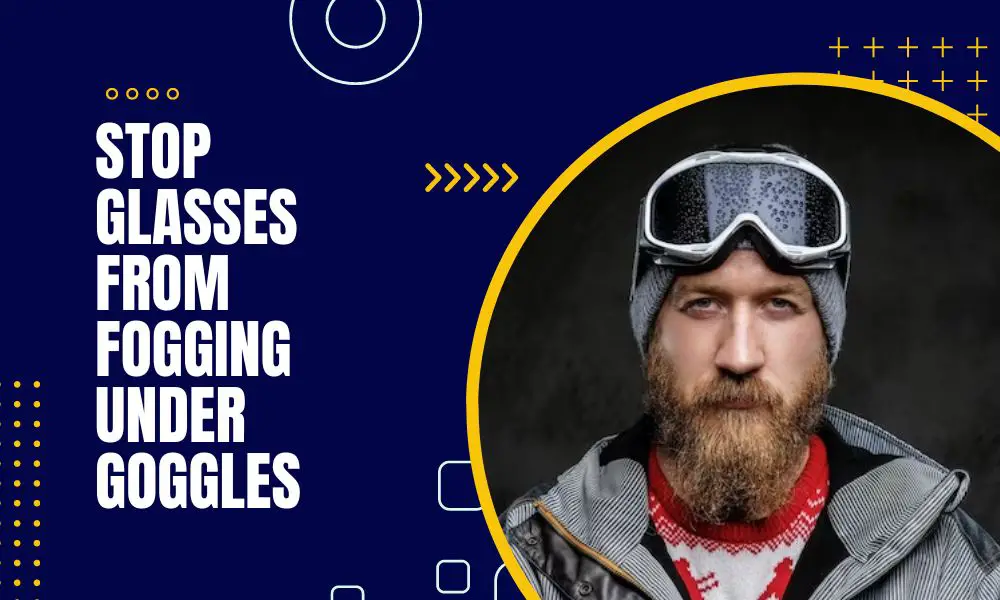People with vision correction glasses have suffered for decades before finally gaining Over-The-Glasses Goggles.
But their struggle is still not over, as now they have been integrated into the wider problem of fogging up which is common to the whole community of snow sports.
You must be thinking that the solution is the same for both, but are they? Read on to find out!
What Causes Fogging Up Of Goggles?
Race your mind back to middle school chemistry when you were taught condensation. Does it ring a bell somewhere? Condensation occurs when hot air comes in contact with cold air/surface. We have experienced this many times before, for example coming out of your air-conditioned room on a hot summer day, but never paid attention to it because it did not necessarily hinder our activity.
But things are different when you are skiing, snowboarding, etc… on the snow! It does hinder your activity, and can cause serious accidents as well! For this purpose, anti-fog coatings and ventilation systems were introduced to combat the problems caused by fogging up. But sometimes, they alone aren’t enough. Sometimes, you need to go out of your way to ensure that your glasses/goggles do not end up fogging.
And when you are wearing glasses under your goggles, you definitely need a better ventilation system and even better anti-fog coatings. You ask why? It should have been clear that since you are wearing two layers of eyewear upon your eyes you need extra features and extra care than regular goggles. Do you not get it?
What Are The Main Reasons That Causes Glasses Inside The Goggles To Fog Up And How To Prevent It?

Temperature Difference
One of the primary reasons for fogging is the temperature difference between the inside and outside of the goggles. The warm air produced by your body and breath, combined with physical activity, creates a higher temperature inside the goggles. When this warm, moist air comes into contact with the colder surface of your glasses, it cools down quickly, causing water vapor to condense into tiny water droplets on the lens, resulting in fogging.
Limited Ventilation
Inadequate ventilation is a common cause of fogging inside ski goggles. Proper ventilation allows fresh air to circulate inside the goggles, helping to regulate the temperature and reduce moisture buildup. However, if the goggles have poor ventilation or are too tightly sealed, the warm, moist air gets trapped inside, increasing the likelihood of fogging on the glasses.
Sweat and Moisture
Physical exertion during skiing or snowboarding can lead to sweating. However, if the ventilation is limited, excess sweat and moisture can accumulate inside the goggles and contribute to fogging on the glasses. But this can’t be rectified since you are bound to sweat a lot when you are playing in the snow. So make sure that the vents of the goggles are situated on the top, bottom, or on the frame itself. For OTG goggles, these places are the best for air to escape effectively and ensure no trapping of moisture inside the goggles.
Also, to pull out the problem right from the root and avoid excess sweating, wear less heavy clothes. Instead of wearing heavy clothes, resort to layering your outerwear. And do not wear large-sized mufflers and scarves near the neck portion. The mufflers will trap moisture stopping them from mixing in the atmosphere and it may lead to fogging up of your glasses again. Please follow these steps!
Facemask Placement
Wearing a mask that directs exhaled breath upward and inside the goggles can increase fogging. The warm air from your breath is directed toward the glasses, causing them to fog up more quickly. Wear a mask in such a way that it doesn’t fully cover your nose, leaving some space for air to escape.
Goggle Fit
The fit of the ski goggles is an essential factor as well. If the goggles are too tight or too loose, it can affect the airflow and create areas of increased moisture buildup, leading to fogging. Thus, choose goggles that are neither very tight nor very loose. Just the perfect snug fit.
Remedies On Preventing Fogging Up Of Glasses Under Ski Goggles

Anti-fog wipes or sprays
Anti-fog wipes or sprays are products specifically designed to prevent fogging on various surfaces, including glasses. These products contain special agents that create a thin and transparent film on the lens, preventing water droplets from condensing into fog. Before heading out to the slopes, apply the anti-fog product to both sides of your glasses lenses.
Proper goggle fit
Ensuring a proper fit between your glasses and the ski goggles is crucial in preventing fogging. Look for ski goggles with an OTG (over-the-glasses) design or those specifically designed to accommodate prescription eyewear. These goggles have additional space in the eye area to comfortably fit your glasses inside.
Ventilation
Look for ski goggles with well-designed ventilation systems, such as vents on the top, bottom, or sides. Proper ventilation allows fresh air to circulate inside the goggles, regulating the temperature and reducing moisture buildup. When warm, moist air is allowed to escape through the vents, it minimizes the chances of fogging on both your goggles and glasses.
Anti-fog inserts or built-in fans
Some ski goggles come with anti-fog inserts or built-in fans to combat fogging. Anti-fog inserts are thin, clear films that can be placed inside the goggles to absorb moisture and prevent fogging. Goggles with built-in fans actively circulate air inside the goggles, expelling warm, moist air and maintaining clear vision. You are right, they are expensive but they can be a good investment.
Facemask placement
The placement of your facemask can increase fogging on your glasses. Ensure that the fabric doesn’t direct your exhaled breath upward, as this can cause warm air to reach your glasses and lead to fogging. Tuck the facemask below the foam padding of the goggles or below the nose to allow the breath to escape freely downward.
Limit facial coverings

In extremely cold conditions, it might feel nice to layer up with multiple face coverings for added warmth. However, wearing thick and multiple layers can trap more warm air, leading to fogging. Choose thinner, moisture-absorbing mufflers and scarves that provide adequate warmth without causing excessive moisture buildup around your glasses.
Keep glasses clean
You do not need someone to remind you that your glasses should always be clean, or do you? Grease and oils from fingerprints or skin can reduce the functioning of anti-fog coatings and cause fogging. Clean your glasses with a suitable lens cleaner and a soft, lint-free cloth before wearing them under the ski goggles.
Lift goggles during breaks
I keep suggesting this to the no-vision-correction goggles people too! It is important to take breaks in between your skiing sessions as it allows you to regulate your body temperature and reduce moisture buildup. During breaks, lift your goggles slightly away from your face to allow airflow and dissipate any accumulated warm air.
Choose the right weather conditions
Since it’s the vision correction group who are seeing this, you can adjust your timings a bit while going skiing and other stuff. While it’s not always possible to control weather conditions, skiing or snowboarding in milder weather or during times when the temperature and humidity levels are lower is better because it reduces the chances of fogging on your glasses and goggles.
How Does Wearing Glasses Under OTG Helps With The Fogging Issues?
OTG goggles are specifically designed with extra space in the eye area to accommodate prescription glasses comfortably. This additional space ensures that the glasses fit inside the goggles without feeling cramped or causing discomfort. Even after wearing the goggles, there is enough room for airflow! OTG goggles eliminate all the extra need for contacts and prescription inserts.
One of the significant advantages of OTG goggles is the improved airflow around your glasses. The extra space in the goggles allows for better ventilation, which helps to reduce the accumulation of warm, moist air from your breath that can cause fogging on your glasses. This enhanced airflow directs exhaled air away from your glasses, preventing moisture from coming into contact with the lenses. As a result, fogging issues are significantly minimized.
Moreover, wearing glasses under OTG goggles preserves the anti-fog properties that may already be present on your prescription lenses. By wearing OTG goggles, the glasses are shielded from the elements and your breath, allowing the anti-fog coatings to work more effectively. This means you can rely on the anti-fog capabilities of your glasses while skiing or snowboarding without worrying about fogging affecting your visibility.
OTG goggles feature foam padding around the eye area, which helps create a seal between the goggles and your face. This seal helps to direct warm air away from your glasses, reducing fogging. The foam padding not only ensures a comfortable fit but also plays a vital role in maintaining clear vision. With the foam seal, you can focus on your winter activities without constantly adjusting your glasses or experiencing fogging-related disruptions.
Conclusion
I hope that by now most of you have got how to save your goggles from the clutches of fogging. Yes, it was this easy!
Now go ahead with your skiing and snowboarding, there is nothing that can stop you!

